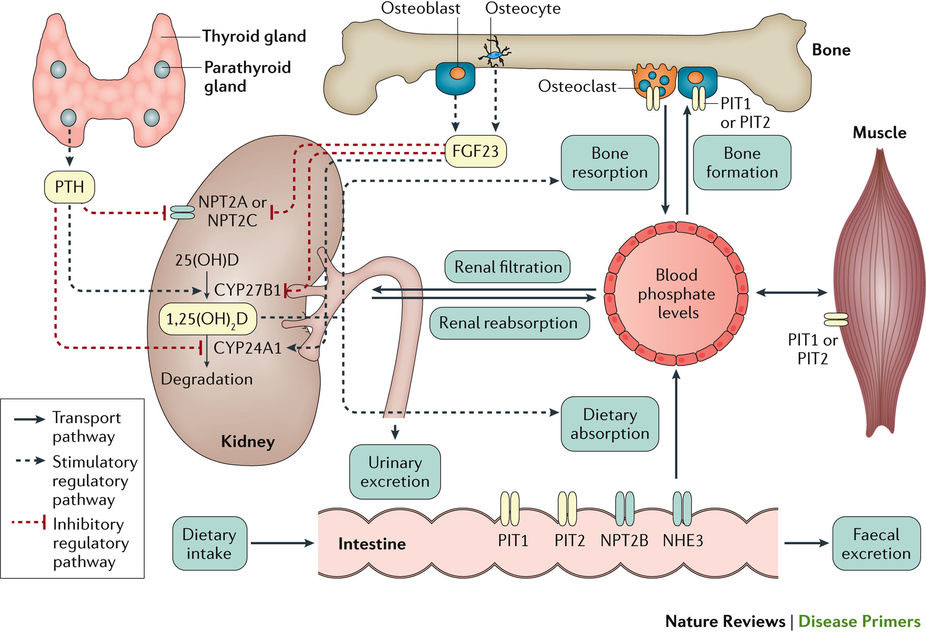腫瘍性骨軟化症
Tumour-induced osteomalacia
2017年7月13日 Nature Reviews Disease Primers Article number: 17044 (2017) doi: 10.1038/nrdp.2017.44

腫瘍性骨軟化症(TIO)は、腫瘍原性骨軟化症としても知られる、まれな腫瘍随伴性障害で、腫瘍組織から分泌される線維芽細胞増殖因子23(FGF23)が原因で発症すると考えられている。FGF23はリン排泄とビタミンD合成に役割を担うため、TIOでは、リンの腎尿細管再吸収の低下、低リン血症、活性型ビタミンD濃度の低下などの特徴が認められる。慢性低リン血症は、最終的に骨軟化症(不十分な骨石灰化)につながる。通常、TIOの診断は、骨の痛み、脆弱性骨折および筋力低下に伴って、慢性的な血清リン濃度の低下が見られる場合に疑われる。腫瘍は非常に小型であることが多く、体内のどこにでも存在し得るため、原因となる腫瘍を発見することは非常に困難である。原因腫瘍が発見できれば、その外科的除去が唯一の決定的治療法になる。原因腫瘍が発見できない場合や完全切除不能例では、リン製剤や活性型ビタミンD製剤による治療が必要となる。現在注目を集めている抗FGF23モノクローナル抗体KRN23は、TIOの原因となる切除不能な腫瘍を有する症例の最も有望な治療法の1つとされている。最近いくつかの腫瘍で、フィブロネクチンと線維芽細胞増殖因子受容体1(FGFR1)との融合分子が、ドライバーとして働くことが同定された。これにより、TIOの病態生理の解明が促進されただけでなく、転写、転座、翻訳後修飾、FGF23分泌促進への理解が深まり、標的療法の開発も検討されている。今後の研究で、転座型でない腫瘍に対するFGFR1経路の影響についても明らかにする必要があるだろう。
PrimeView
腫瘍性骨軟化症(TIO)は、腫瘍からの線維芽細胞増殖因子23分泌によって発症し、低リン血症と骨格異常を特徴とする。TIOの原因腫瘍は、小型の場合が多く、体内のすべての軟組織や骨に発生する可能性があるため、発見するのが困難である。
本Primerの図解サマリー
Tumour-induced osteomalacia (TIO), also known as oncogenic osteomalacia, is a rare paraneoplastic disorder caused by tumours that secrete fibroblast growth factor 23 (FGF23). Owing to the role of FGF23 in renal phosphate handling and vitamin D synthesis, TIO is characterized by decreased renal tubular reabsorption of phosphate, by hypophosphataemia and by low levels of active vitamin D. Chronic hypophosphataemia ultimately results in osteomalacia (that is, inadequate bone mineralization). The diagnosis of TIO is usually suspected when serum phosphate levels are chronically low in the setting of bone pain, fragility fractures and muscle weakness. Locating the offending tumour can be very difficult, as the tumour is often very small and can be anywhere in the body. Surgical removal of the tumour is the only definitive treatment. When the tumour cannot be located or when complete resection is not possible, medical treatment with phosphate salts or active vitamin D is necessary. One of the most promising emerging treatments for unresectable tumours that cause TIO is the anti-FGF23 monoclonal antibody KRN23. The recent identification of a fusion of fibronectin and fibroblast growth factor receptor 1 (FGFR1) as a molecular driver in some tumours not only sheds light on the pathophysiology of TIO but also opens the door to a better understanding of the transcription, translocation, post-translational modification and secretion of FGF23, as well as suggesting approaches to targeted therapy. Further study will reveal if the FGFR1 pathway is also involved in tumours that do not harbour the translocation.

